FROM DRACHMA TO EURO
The history of drachma
Drachma has been the national currency of our country since 1833. Actually,
it was originally introduced by Fedon from Egina, at the beginning of
the 7th century BC. He was the one to 'cut' a coin made of iron that was
the equivalent of 6 'ovolos' -the currency at that time. The new coin
was named drachma deriving from the ancient Greek word drax the
hand, as only 6 'ovolos' could be held in one hand. Later, in 8 October
1833 under the reign of king Othon the drachma was officially established
as the national currency of Greece.
The introduction of the euro banknotes and coins in Greece and the other
11 countries of the euro area on 1st January 2002 ended the journey of
the drachma through history. Finally, drachma ceased to be the Greek national
currency on 28 February 2002.
The history of euro
On 1 January 1999 eleven European Union Member States (Belgium, Germany, Spain, France, Ireland, Italy, Luxembourg, the Netherlands, Austria, Portugal and Finland) adopted the euro as their national currency (in scriptural form). These Member States were selected by the European Council in early May 1998 to participate in the European Monetary Union, since they had fulfilled the convergence criteria laid down in the Maastricht Treaty. On 19 June 2000, the EU Council at its meeting in Santa Maria da Feira, having assessed that Greece fulfils the requirements of the Treaty, approved its accession to the euro area as a twelfth member as from 1.1. 2001. At the same time, the irrevocable conversion rate of the drachma vis ΰ vis the euro was set at GRD 340.750 effective from 1 January 2001, which is equal to its central rate within the Exchange Rate Mechanism, applying as of 17 January 2000.
The euro banknotes
The final designs of the euro banknotes were announced in December 1996 at the Dublin, European Council. There are 7euro banknotes in different colours and sizes they are denominated in 500, 200, 100, 50, 20, 10 and 5 euros. The notes are uniform throughout the euro area; unlike coins, they have no national side. The designs are symbolic for Europe's 7 different architectural periods that are represented by three main architectural elements: windows, gateways and bridges. Windows and gateways dominate the front side of each banknote as symbols of the spirit of openness and cooperation in the EU. The reverse side of each banknote features a bridge from a particular age, a metaphor for communication among the people of Europe and between Europe and the rest of the world
The euro coins
There are 8 euro coins denominated in 50, 20, 10, 5, 2 and 1 cents, then
in 2 and 1 euros. The euro coins, unlike banknotes which are uniform, carry
a common European face, while motifs on the other side form a link with the
national identities of each Member State. The coins can be used anywhere
inside the 12 Member States euro area regardless of their motif. Final designs
of the common European face of the coins were agreed at the European Council
meeting in 1997 and they represent the Union of the Member States of the
European Union.
The Greek themes on euro coins
There are eight different coins,
corresponding to the following denominations:
2 euros, 1 euro, 50 euro cents,
20 euro cents, 10 euro cents, 5 euro cents, 2 euro cents and 1 euro cent.
The designs on one side of the euro coins are common to all the countries
of the euro area, while the other side forms a link with the national
identities.
The Greek
national sides are the following:
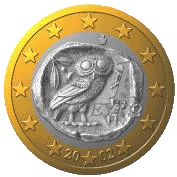
1-euro denomination
Depicting an owl, a design taken from an ancient Athenian 4- drachma coin.
 2-euro
denomination
2-euro
denomination
Depicting a scene from mythology,
i.e. Europa -where the name of our continent originates- being abducted
by Zeus in the shape of a bull (from a mosaic in Sparta), 3rd century
BC.
 50-cent
denomination
50-cent
denomination
Depicting Eleftherios Venizelos
(1864-1936)
One of Greece's most important
political figures. Seven times Prime Minister, Eleftherios Venizelos was
a pioneer in social reform and a versatile diplomat. He played a prominent
role in the victorious military campaigns of 1912-1920.
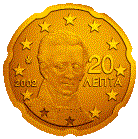 20-cent
denomination
20-cent
denomination
Depicting Ioannis Capodistrias
(1776-1831)
A leading national and European
politician and diplomat, first Governor (1830-1831) of Greece after the
War of Independence (1821-1827). After taking charge of the final stage
of the revolution and playing a decisive role in the ultimate victory,
Ioannis Capodistrias made notable contributions in such fields as domestic
policy, education, justice, public works, social welfare, agriculture,
stock breeding, trade and shipping.
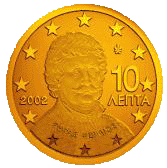 10-cent denomination
10-cent denomination
Depicting Rigas Velestinlis-Fereos
(1757-1798)
A forerunner and leading figure
of Greek Enlightenment, Rigas Velestinlis-Fereos was also a visionary
and a herald of the Balkans liberation from Ottoman rule. A fervent defender
of the movement for Greece's independence and a martyr of the then-enslaved
nation.
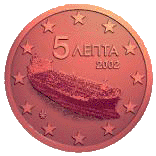 5-cent denomination
5-cent denomination
Depicting a modern tanker ship.
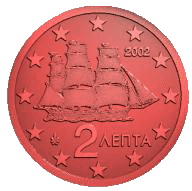 2-cent
denomination
2-cent
denomination
Depicting a Corvette, that is
a type of ship used during the Greek War of Independence (1821- 1827)
 1-cent denomination
1-cent denomination
Depicting an advanced model of an Athenian trireme, the biggest and most
important ship of the Athenian fleet, dating from the times of Kimon, 5th
century BC.